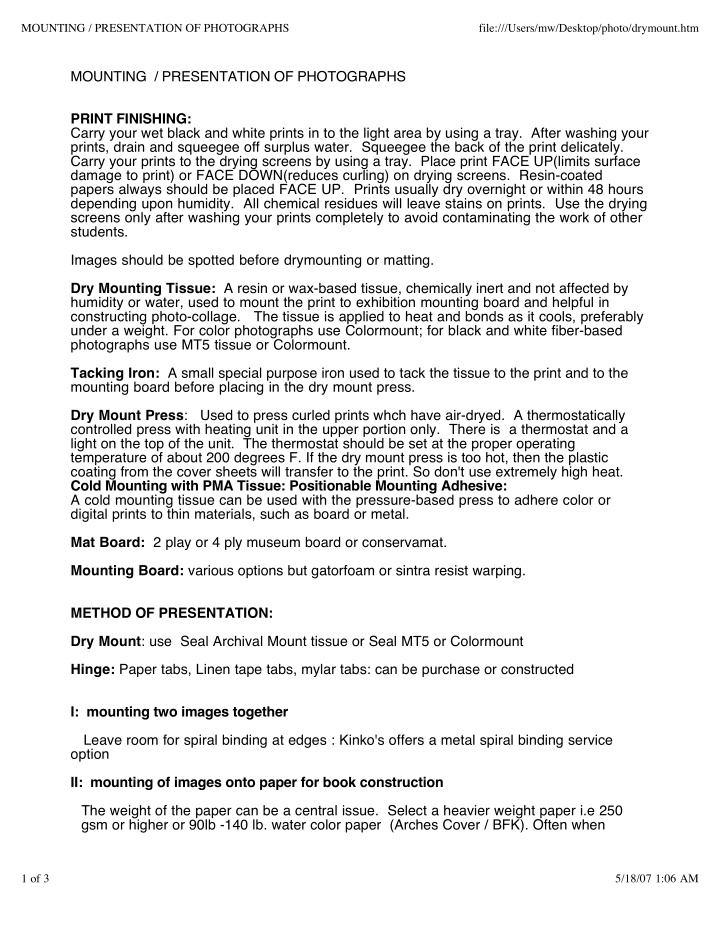



MOUNTING / PRESENTATION OF PHOTOGRAPHS file:///Users/mw/Desktop/photo/drymount.htm MOUNTING / PRESENTATION OF PHOTOGRAPHS PRINT FINISHING: Carry your wet black and white prints in to the light area by using a tray. After washing your prints, drain and squeegee off surplus water. Squeegee the back of the print delicately. Carry your prints to the drying screens by using a tray. Place print FACE UP(limits surface damage to print) or FACE DOWN(reduces curling) on drying screens. Resin-coated papers always should be placed FACE UP. Prints usually dry overnight or within 48 hours depending upon humidity. All chemical residues will leave stains on prints. Use the drying screens only after washing your prints completely to avoid contaminating the work of other students. Images should be spotted before drymounting or matting. Dry Mounting Tissue: A resin or wax-based tissue, chemically inert and not affected by humidity or water, used to mount the print to exhibition mounting board and helpful in constructing photo-collage. The tissue is applied to heat and bonds as it cools, preferably under a weight. For color photographs use Colormount; for black and white fiber-based photographs use MT5 tissue or Colormount. Tacking Iron: A small special purpose iron used to tack the tissue to the print and to the mounting board before placing in the dry mount press. Dry Mount Press : Used to press curled prints whch have air-dryed. A thermostatically controlled press with heating unit in the upper portion only. There is a thermostat and a light on the top of the unit. The thermostat should be set at the proper operating temperature of about 200 degrees F. If the dry mount press is too hot, then the plastic coating from the cover sheets will transfer to the print. So don't use extremely high heat. Cold Mounting with PMA Tissue: Positionable Mounting Adhesive: A cold mounting tissue can be used with the pressure-based press to adhere color or digital prints to thin materials, such as board or metal. Mat Board: 2 play or 4 ply museum board or conservamat. Mounting Board: various options but gatorfoam or sintra resist warping. METHOD OF PRESENTATION: Dry Mount : use Seal Archival Mount tissue or Seal MT5 or Colormount Hinge: Paper tabs, Linen tape tabs, mylar tabs: can be purchase or constructed I: mounting two images together Leave room for spiral binding at edges : Kinko's offers a metal spiral binding service option II: mounting of images onto paper for book construction The weight of the paper can be a central issue. Select a heavier weight paper i.e 250 gsm or higher or 90lb -140 lb. water color paper (Arches Cover / BFK). Often when 1 of 3 5/18/07 1:06 AM
MOUNTING / PRESENTATION OF PHOTOGRAPHS file:///Users/mw/Desktop/photo/drymount.htm drymounting to a lighter weight sheet of paper or to some synthetic papers light inkjet paper, the photograph will either curl or lift from the paper. If you are drymounting be careful to use a paper that is smooth--such as a hot press water color paper. Use a higher quality paper such as 100% cotton rag or at least 50% rag content. Other acceptable papers would be acid-free papers, nuetral PH papers or perhaps a 25% cotton cardstock. Photographs can be placed onto pages by "cutting corners" into a heavyweight paper. This process would be suitable for the album binding style and is reminiscent of the old black photo corners...without the corner The best drymount tissue available is Seal Archivalmount; this tissue bonds as it cools and is reversible. Seal MT5 is a suitable alternative for black and white papers but is not reversible. III: mounting of images onto board You may select board of varying thicknesses depending upon the application --board usually is available as: 4ply (a standard cardboard thickness) or 2ply (similar to a very heavy cardstock) Boards are available in a variety of types: 1- standard matboard : often is not acid-free and is still expensive...it's a waste of money...grey core 2- museum board : 100% rag and usually available in a range of white tones... locally from Film Depot, Asel's Art Supply, or can be ordered from Stephen Kinsella 1-800-445-8865 --po box 32420 Olivette MO 63132 --minimum $25.00 charge...order with friends 3- conservation board : an acid-free board that is not 100% rag / slightly lower in cost but still expensive 4- non-buffered museum board : for color photographs and sensitive archival materials that are not appropriate for a buffered or slightly alkaline environment 5- foam board : available at office and art supply stores...will work for some projects on occasion / archival foam board can be mail-ordered / can be difficult to cut / prone to warping, especially at larger sizes 6- gatorform: similar to foamcore, but must be cut with a saw / will not warp and resists denting/ available at plexi suppliers / order to size and trim down print after mounting. Also available in pre-cut sizes from Asel Art Supply in Richardson. (8x10, 13x19, 16x20) 7- sintra: a lightweight plastic, that is available in various colors / must be cut with a saw / will not warp and resists denting/ available at plexi suppliers / order to size and trim down print after mounting 2 of 3 5/18/07 1:06 AM
MOUNTING / PRESENTATION OF PHOTOGRAPHS file:///Users/mw/Desktop/photo/drymount.htm 8- binder's board: used for contruction of book and boxes IV: Miscellaneous surfaces such as wood or metal . Experiment with adhesives and coatings to fuse image to substrate and perhaps to seal image surface. Adhesives include Positionable Mounting Adhesive PMA. Glues that are similar to Elmers may work but the moisture will introduce curling. Glazing materials include Acrylic matte or gloss varnishes and polyurethane. Plastic lamination is also an option. V-Find an existing structure that will "hold" your photograph such as a window frame, wooden box, or glass jar. 3 of 3 5/18/07 1:06 AM
Recommend
More recommend